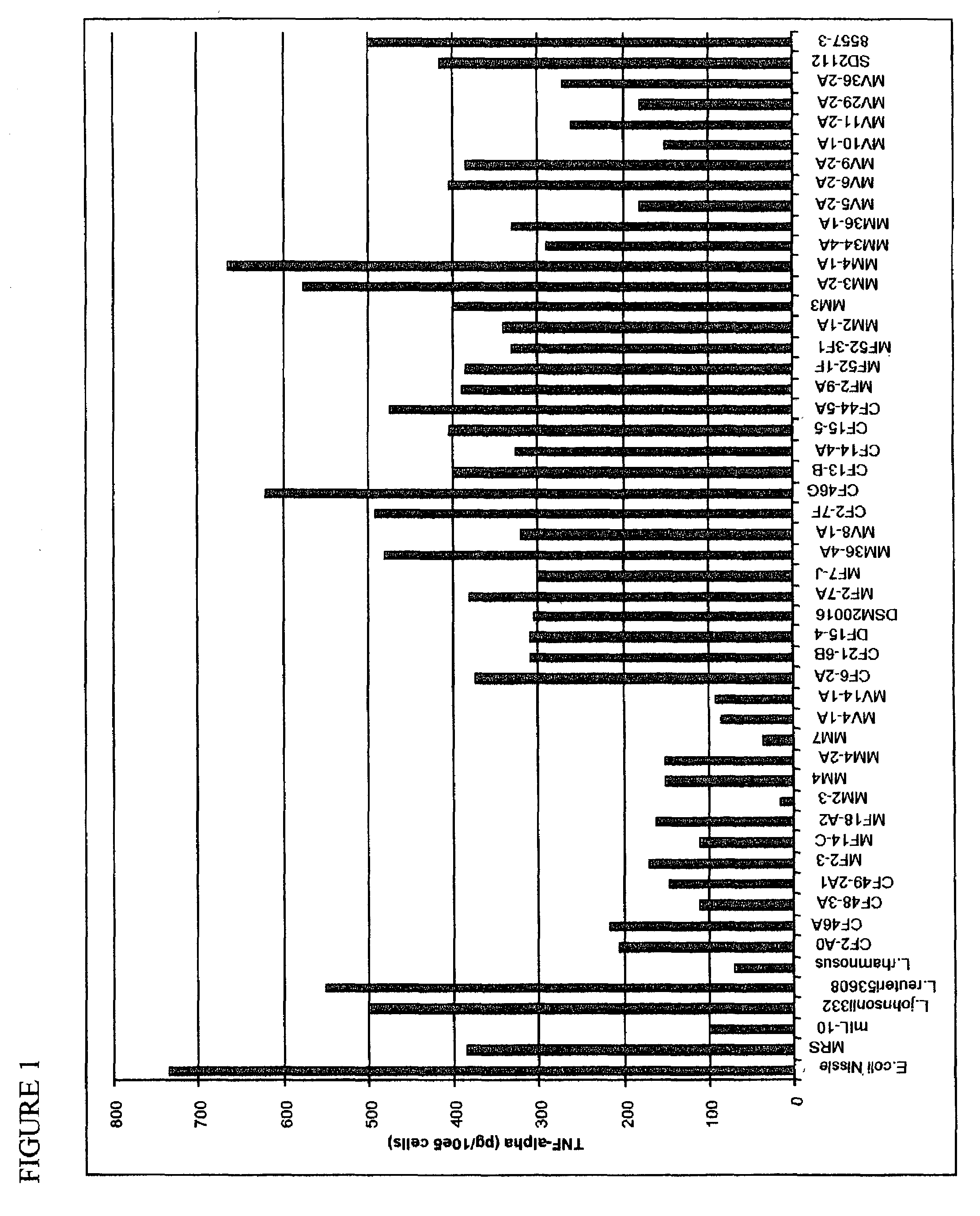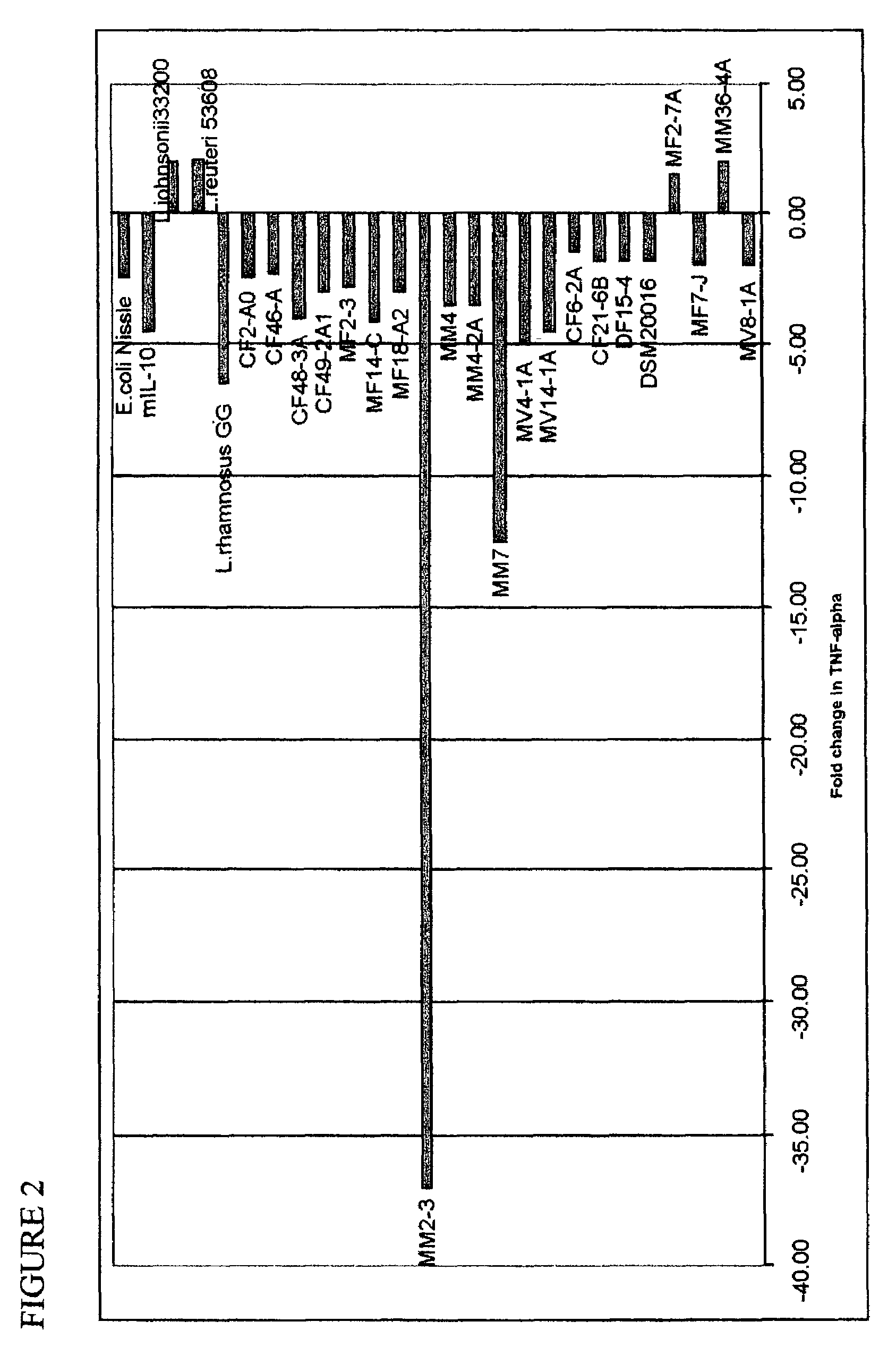Selection and use of lactic acid bacteria for reducing inflammation caused by Helicobacter
a technology inflammation, which is applied in the field of selection and use of lactic acid bacteria for reducing inflammation caused by helicobacter, can solve the problems of increased risk of developing gastritis, so as to reduce gastrointestinal inflammation and treat or prevent inflammation
- Summary
- Abstract
- Description
- Claims
- Application Information
AI Technical Summary
Benefits of technology
Problems solved by technology
Method used
Image
Examples
example 1
Selection of Anti-Inflammatory Strains.
[0025]Lactobacillus spp. (including for example L. rhamnosus GG ATCC 53103, L. johnsonii ATCC 33200, L. reuteri MM2–3 ATCC PTA-4659, L. coryniformis, MM7, ATCC PTA-4660) and E. coli Nissle were grown in de Man, Rogosa, Sharpe (MRS) and Luria-Bertani (LB) media (Difco, Sparks, Md.), respectively. Overnight cultures of lactobacilli were diluted to an OD600 of 1.0 (representing approximately 109 cells / ml) and further diluted 1:10 and grown for an additional 4, 8 and 24 h. Helicobacter pylori, (Sydney strain SS1) and Helicobacter hepaticus 3B1(ATCC 51449) were cultured for 48 h in Brucella broth (Difco) supplemented with 10% fetal bovine serum (FBS). Cultures were diluted 1:10 and grown for another 24 and 48 h. Bacterial cell-free conditioned medium was collected by centrifugation at 8500 rpm for 10 min at 4° C. Conditioned medium was separated from the cell pellet and then filtered through a 0.22 μm pore filter unit (Millipore, Bedford, Mass.).
[00...
example 2
Use of the Conditioned Medium
[0030]Using the method above, the conditioned medium from one effectively TNFα decreasing strain was selected, in this experiment the medium from L. reuteri ATCC PTA4659. This medium was produced in larger scale by growing the strain in de Man, Rogosa, Sharpe (MRS) (Difco, Sparks, Md.). Overnight cultures of lactobacilli were diluted to an OD600 of 1.0 (representing approximately 109 cells / ml) and further diluted 1:10 and grown for an additional 24 h. Bacterial cell-free conditioned medium was collected by centrifugation at 8500 rpm for 10 min at 4° C. Conditioned medium was separated from the cell pellet and then filtered through a 0.22 μm pore filter unit (Millipore, Bedford, Mass.). The conditioned medium was then lyophilized and formulated, using standard methods, to make a tablet. This tablet was used as a drug by humans to treat ulcer caused by H. pylon.
example 3
DNA-Fingerprinting of Lactobacillus reuteri Strains
[0031]The method of U.S. Pat. Nos. 5,523,217 and 5,691,136 of Lupski et al. was used to do genomic fingerprinting of L. reuteri strains. This method utilizes amplification of the bacterial DNA by adding a pair of outwardly-directed primers to the bacterial sample. After amplification, the extension products of the resulting hybridization are separated by size, and the strain of bacteria is characterized by measuring the pattern of sized extension products Duplicate gel images were obtained for 82 strains of L. reuteri by Bacterial BarCodes, Inc. (Houston, Tex.) using the Uprime E primer (one primer) The duplicate sets of data were comparable. There were a total of 11 clusters, which were different from each other, and eight outliers, which appeared to be unique.
[0032]The strains found to be effective in reducing the TNF-α (see FIGS. 1 and 2) do not group together using this method, showing that it is not sufficient to use DNA-finger...
PUM
| Property | Measurement | Unit |
|---|---|---|
| Strain point | aaaaa | aaaaa |
Abstract
Description
Claims
Application Information
 Login to View More
Login to View More - R&D
- Intellectual Property
- Life Sciences
- Materials
- Tech Scout
- Unparalleled Data Quality
- Higher Quality Content
- 60% Fewer Hallucinations
Browse by: Latest US Patents, China's latest patents, Technical Efficacy Thesaurus, Application Domain, Technology Topic, Popular Technical Reports.
© 2025 PatSnap. All rights reserved.Legal|Privacy policy|Modern Slavery Act Transparency Statement|Sitemap|About US| Contact US: help@patsnap.com


